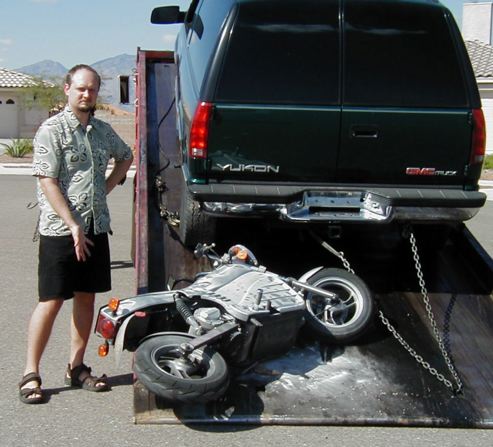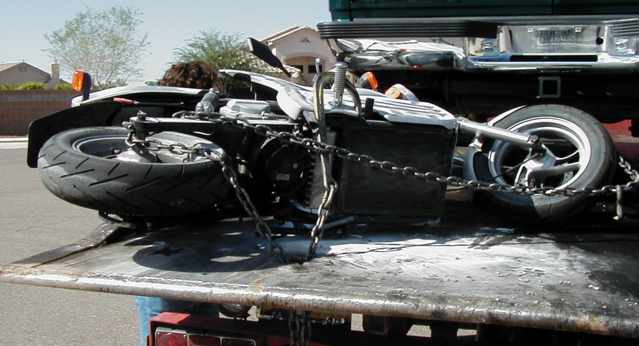Winter 2002: Epilogue
Totaled
I called my insurance company (Farmer’s) and made a claim for the fire. I didn’t know what they would do. Maybe wait for me to repair the Lectra and then reimburse me? I began to correspond with Scott Cronk again about where I might get new dash electronics and a new faring, but even as I made this plan, I was despairing, because of the size of the rewiring job, and basically having to rebuild it.
To my surprise, when they came to take a look, they totaled it. They said that in general that’s what they do with motorcycles, because spare parts are often hard to find and it’s hard to find someone willing to rebuild. In the case of my Lectra, this would be far harder. It’s out of production, and it’s difficult to find a shop willing to replace even standard parts.
I asked, what did they do with totaled motorcycles? Could I save the motor and chain assembly? No, they don’t allow owner retention of parts in the case of fire, because of liability.
What if I wanted to buy it back? Well, then I would have to go to Phoenix and bid on it in an auction along with everyone else. Then I would have to rebuild it, and get a new VIN for it, and get someone besides Farmer’s to insure it. I suppose my final option would have been to refuse the offer but get someone else to insure it, while I rebuilt the Lectra at my own expense.
I waited to hear what Farmer’s would offer me for the Lectra. As it turned out, they offered me a very reasonable price, a bit over half of what I bought it for. I compared this to the time and trouble of having to rebuilt my burnt Lectra myself, and decided to accept the offer.
It was not an easy decision. Once in awhile I wonder if I should have taken on the task. I really hate to throw away something that can be repaired, and I think that the Lectra, though badly damaged, could have been fixed. I know I would have learned a lot. I would also, by the end of it, I’m sure, bought a lot of new tools, spent a lot of time, money, and hassle, and might have had continuing troubles with insurance and the DMV.
Scott Cronk, the inventor, told me what he knew about the suppliers of the faring and the circuit boards and offered any help he could to get me riding again, which I truly appreciated. A couple of different friends offered their help in rebuilding it. Some people suggested I consider the rebuild a hobby.
If I haven’t already, I should say something about what I do for my work. I’m a software engineer, and I spent my whole day building and debugging things. Although the Lectra is not software, let me assure you that the mental process is very much the same. What I need for a hobby is some kind of departure from that.
One of the things that attracted me to the Lectra, and to electric vehicles in general, is the reduced maintenance. (See my NO poster.) All other things being equal, electrics are easier to maintain than gas vehicles. But all other things are not equal, not today. I knew I was taking on a part-time mechanic job when I had Scott Cronk mail me the bike from Sebastopol: I wasn’t near a dealer of any kind. And when EMB was bought by ZAP, I knew it was going to get worse. After having just faced the Trial By Parts earlier this year, I didn’t have the heart left to take on the significant rebuild effort this last incident would require.
Towed
And so the day came at last for the remains of the Lectra to be towed away to auction: October 18, 2002. I left the address of this website on a Post-It in a Ziploc bag that contained some of its miscellaneous bolts and washers. Perhaps its next owner could use the information here if they intend to rebuild it.
Here is a picture of me next to the Lectra as it prepares to take its place alongside the other car being towed that day:

And here is the final image of it as it headed away from my house for good:

Back to the Bus and the Bike
In the three and a half years while I was riding the Lectra, the bus routes had extended farther out toward my house, so that it was only a 15-minute walk or so now to the nearest stop. While I try to decide what kind of transportation I should get next, the bus, the bike, and carpooling are the way I’m getting to work these days.
The bus has not reformed itself entirely, though. Although the buses are timely getting to work, coming home, the bus has sometimes been up to a half an hour late, which is infurating.
My bike is still in good condition, and I still ride it for fun sometimes up to the Saguaro National Monument. It’s been a long time since I rode it to work. I tried that again, and it was OK, but as before, the exhaust fumes are really pernicious on the way home.
Future Plans
So what should I use to ride to work, long-term? Here are some of the things I’ve thought about:
- The Segway. It’s on sale now at Amazon. It costs $5000, a bit more than I paid for my Lectra three years ago. The specs are not exciting compared to the lectra: top speed of 12.5 mph; range of only 10 miles. Also, I’d have to ride it on the sidewalk. It would probably get me to work in about the same amount of time that a bike would.
- An electric bicycle. This is something else I had considered in the original “courtship”. At the time I didn’t like the idea because it was still travel in the bike lane, not as fast as the Lectra. I still prefer the idea of an electric motorcycle to an electric bicycle, but one advantage of the bicycle would be that I would get a little exercise —not too much, and not none. These cost about $2000 or so.
- A gas-powered scooter. Although it would be (sigh) gas-powered, it would be incredibly more efficient than almost any other gas-powered vehicle. I really like the look of the Honda Elite, for example. A gas- powered full-up motorcycle is another idea. I like two-wheelers, and it makes sense for commuting. I still have a hard time going the gas route, but this would be the most minimal way to do it. Its range and top speed would be much more than the Lectra’s. Probably around $3000 new.
- The GM EV1. I had looked at this one three years ago. I thought I’d see what the price was like now. No such luck. It’s out of production as well. The world seems to be saying to me, “Give up on pure electrics.”
- The EV Sparrow. This is a one-seater, three-wheeled, enclosed electric car, still in production. Takes the same batteries as the Lectra (Optima Yellow Top). High top speed (70 mph) and range (40 miles). The big problem is the big price tag: about $15,000! That’s a lot to pay for a single-seater vehicle. Also, I worry about the heat: it doesn’t have air conditioning, but is enclosed. This is a bad recipe in an Arizona summer. The windows do go down, but as anyone knows who lives here, that might not be enough. A motorcycle avoids this pretty well by not being enclosed. Still, I can’t deny an attraction to the Sparrow—one of the only ways to drive an electric car today.
- Diesel. The “alternative petroleum”. Tremendous gas mileage,
and maybe an excuse to drive a new VW Beetle. They have diesel Beetles at
the dealership in town. Only drawback is that it does have emissions,
and they’re not automatically healthier than those of regular gasoline. Diesel
has gotten cleaner in the last few years, but I still feel some conflict
about it.
One thing I do worry about if I go with a car that has more than one seat is that we won’t ever be able to give up being a two-car family. I’m sure we won’t. It’s like cell phones and air conditioning: one you’ve tasted it, there’s no going back. So part of my strategy is to avoid getting a vehicle that carries more than one passenger.
Finally, it’s a lot more expensive than the other options on this list. New ones are between $19,000 and $21,000. - Gas-Electric Hybrids. Same issues with these as with the diesel: although cool and alternative, still takes gas, still has emissions, costs in the $20,000 range, and moves us into the two-car family scenario for good. A couple of my friends own the Toyota Prius, and they like it, getting between 45 and 60 mpg, depending on how they drive. I also hear good things about the new Honda Civic hybrid. I imagine we’ll all be seeing plenty of that car on the roads, which is definitely a good thing. I just don’t know if it’s quite what I’m looking for yet.
- Fuel-cell vehicles. These, of course, are the coolest of all possible worlds. The only problem is that of this writing, they do not yet exist for people like me to buy. One thing I could do is just save my pennies while I bike and bus, hoping that sometime in the next three years or so the fuel cell vehicles make it to dealerships.
So what to do? I don’t feel a tremendous pull in any one direction, the way I felt pulled to the Lectra. So I’ll wait and watch. My wife thinks I should just lease a diesel Beetle for a couple of years till the fuel cells come out. Not a bad idea. The full-size car options (diesel, hybrid) are likely to have much greater resale value than the more fringe options. Stay tuned.
Audited
On November 30, 2002, I received a letter from the Arizona Department of Revenue telling me that I had been selected for an audit. The letter is here:
As you can see, questions about the Lectra are foremost in their minds.
I wasn’t too surprised to get this; Arizona has been having serious budget problems, and some of them are traceable to the overly generous tax credit for tax year 1999, the year I bought the Lectra. I suppose they are trying to make sure that everyone who said they bought an electric vehicle really did.
It’s a little difficult to piece together receipts and email from over three years ago, but I’m doing it. I have a feeling I’m going to be on the phone a lot with Ms. Jean Granger. I bought the Lectra via email and paid it off with a couple of different credit cards, so its purchase was a little unconventional.
I also wish that this audit had come while I still had the Lectra. The first thing they want to see is a copy of the title, but that belongs to Farmer’s now. More news at it develops.
Read on to discover how the State of Arizona tried to shake me down.

